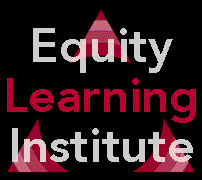 Home Home
 Teachers Corner Teachers Corner
 Workshops & Training Workshops & Training
 Equity Case Studies Equity Case Studies
 Awareness Activities Awareness Activities
 Equity Curriculum Equity Curriculum
 Equity Awareness Quizzes Equity Awareness Quizzes
 Printable Handouts Printable Handouts
 Research Room Research Room
 Humane Education Humane Education
 Social Justice Speeches Social Justice Speeches
 Social Justice Songs Social Justice Songs
 Social Justice Quotations Social Justice Quotations
 Multicultural Links Multicultural Links
 Contact Us Contact Us
 Receive Email Updates Receive Email Updates
 Awards & Recognition Awards & Recognition
 About Paul Gorski About Paul Gorski




|
Inclusion/Exclusion
This
activity requires 30-45 minutes.
Purpose:
Participants
share their experiences as students, exploring different ways people
are made to feel "included" in and "excluded" from the learning process. Topics emerging from this activity include (1) the range of learning styles and needs in any group of people, (2) the importance of reflective practice and understanding one's own socialization, and (3) the power teachers have through both implicit and explicit actions.
Preparation:
Divide
participants into small groups of four or five.
Instructions:
- Ask
participants to do a five-minute free write based on two prompts: (1) Recall a
time from your own schooling when you felt especially included, engaged, appreciated, and validated in
the learning process; and (2) Recall a situation
when you felt especially excluded, alienated, and invalidated from the learning process. Without being too directive, let students know that the reasons for their feelings of inclusion and exclusion could vary broadly, from the way a certain teacher taught to a lack of feelings of support to social reasons.
- In their small groups, ask participants to share the parts of their stories they feel comfortable sharing. Once everybody has shared both stores, ask them to reflect upon the similarities and differences in their stories.
- Return students to the big group and ask a few people to share their stories with the whole class.
- Request
a volunteer to record brief notes about both categories of stories.
(What makes students feel included? What makes them feel excluded?)
- Facilitate
a discussion about the notes, examining consistencies and differences
in individuals' stories and learning needs. Often I ask participants how many of them found it easy to recall both an inclusion and an exclusion story. Most participants respond that it was easy. This allows me to make the point that we, as teachers, have tremendous power--that even when we don't intend to do something wrong, we might do something that has a lifelong impact on one of our students. This is why developing reflective practice skills is critical to anybody committed to educational equity. Other sample questions to guide the
conversation:
- What
similarities do you observe among the situations in which people felt
especially included in a learning process?
- What
consistencies do you notice in the situations in which people
felt excluded?
- Knowing that we have students with various needs and learning styles, what can we do to ensure we are including, engaging, and validating all learners?
Facilitator
Notes:
It is
always important when activities call for participants to share their
own stories and make themselves vulnerable to remind the group about
active listening. Consider starting the activity by sharing your own
set of stories to ease the tension.
This activity
provides a perfect opportunity to challenge teachers to reexamine their
own teaching practices. Challenge them to think about their own teaching
as they engage in this activity and hear each other's stories. You might even reframe this activity to have teachers consider ways in which they unintentionally realized they were alienating or excluding one or more students.
[ Return to the Awareness Activities Page ]
|




